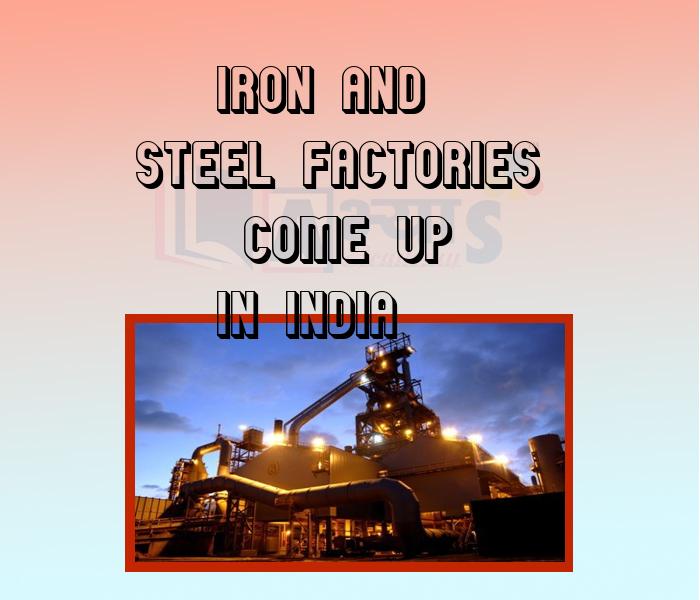Iron and Steel Factories Come Up in India












Iron and Steel Factories Come Up in India
Iron and steel factories come up in India: The year was 1904. In the hot month of April, Charles weld, an American geologist and Dorabji Tata, the eldest son of Jamsetji Tata, were travelling in Chhattisgarh in search of iron ore deposits. They had spent many months on a costly venture looking for sources of good iron ore to set up a modern iron and steel plant in India. Jamestji Tata had decided to spend a large part of his fortune to build a big iron and steel industry in India. One day, after travelling for many hours in the forests, weld and Dorabji came upon a small village and found a group of men and women carrying basket loads of iron ore. These people were the agarias. When asked where they had found the iron ore, the agarias pointed to a hill in the distance. Weld and Dorabji reached the hill after an exhausting trek through dense forests. On exploring the hill the geologist found what they had been looking for. Rajhara hills had one of the finest ores in the world. But there was a problem. The region was dry and water- necessary for running the factory- was not to be found nearby. The Tata’s had to continue their search for a more suitable place to set up their factory. However, the agarias helped in the discovery of a source of iron ore that would later supply the Bhilai steel plant. A few years later a large areas of forest was cleared on the banks of the river Subarnarekha to set up the factory and an industrial township- Jamshedpur. The Tata iron and steel company (TISCO) that came up began producing steel in 1912.TISCO was set up at an opportune time.
In the late nineteenth century, India was a importer of steel which was manufactured in Britain.The first successful attempt was made in 1875 in setting up an iron and steel works at Barakar by Bengal Iron and Steel Company. This was taken over by Bengal Iron Company in 1889. Expansion of the railways in India had opened up a huge market for the British steel. The British experts in the Indian Railways largely imported British steel because they were unwilling to believe that good quality steel could be produced in India. However, after 1914 when the First World War broke out, the situation changed. Steel produced in Britain now had to meet the demands of war in Europe.Imports of British steel into India declined dramatically and the Indian Railways turned to TISCO for supply of rails. As the war dragged on for several years, iron and steel companies began to be set up in India to fulfill the domestic demands of steel.
Students / Parents Reviews [10]
It has a great methodology. Students here can get analysis to their test quickly.We can learn easily through PPTs and the testing methods are good. We know that where we have to practice

Barkha Arora
10thAbout Abhyas metholodology the teachers are very nice and hardworking toward students.The Centre Head Mrs Anu Sethi is also a brilliant teacher.Abhyas has taught me how to overcome problems and has always taken my doubts and suppoeted me.

Shreya Shrivastava
8thIt was good as the experience because as we had come here we had been improved in a such envirnment created here.Extra is taught which is beneficial for future.

Eshan Arora
8thBeing a parent, I saw my daughter improvement in her studies by seeing a good result in all day to day compititive exam TMO, NSO, IEO etc and as well as studies. I have got a fruitful result from my daughter.

Prisha Gupta
8thMy experience was very good with Abhyas academy. I am studying here from 6th class and I am satisfied by its results in my life. I improved a lot here ahead of school syllabus.

Ayan Ghosh
8thOne of the best institutes to develope a child interest in studies.Provides SST and English knowledge also unlike other institutes. Teachers are co operative and friendly online tests andPPT develope practical knowledge also.

Aman Kumar Shrivastava
10thA marvelous experience with Abhyas. I am glad to share that my ward has achieved more than enough at the Ambala ABHYAS centre. Years have passed on and more and more he has gained. May the centre flourish and develop day by day by the grace of God.

Archit Segal
7thAbhyas is a complete education Institute. Here extreme care is taken by teacher with the help of regular exam. Extra classes also conducted by the institute, if the student is weak.

Om Umang
10thAbhyas Methodology is very good. It is based on according to student and each child manages accordingly to its properly. Methodology has improved the abilities of students to shine them in future.

Manish Kumar
10thMy experience with Abhyas is very good. I have learnt many things here like vedic maths and reasoning also. Teachers here first take our doubts and then there are assignments to verify our weak points.
